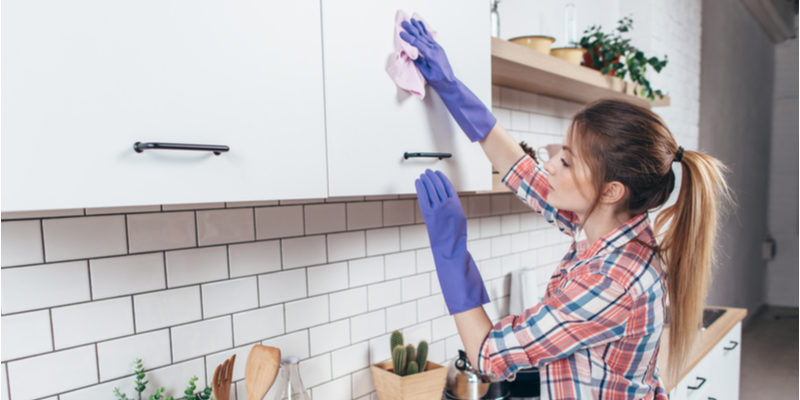While you likely clean your counters on a daily basis, and sweep and mop your kitchen floor regularly, you kitchen cabinets probably don’t get the same attention. Though you wipe down the exterior doors occasionally, you probably don’t remember the last time you actually cleaned your kitchen cabinets. If you are like most people, you don’t think about the dust, splatters, dirt, and grease which sticks to your cabinet surfaces until it becomes a difficult to remove mess which can even pose a health hazard (bacteria) for those who frequent your kitchen. Bacteria (salmonella and more) can infiltrate your cabinets and contaminate plates, cups, utensils, and more and no one wants that! Deep cleaning your kitchen cabinets on a regular basis not only keep improve the longevity and overall appearance of your cabinets but keep your family safe from contaminants as well.
Cabinet Cleaning – The Frequency
You should wipe down the outside of your cabinets weekly. If you get in a pinch with a busy week, you can do it every other week. The interior of your cabinets can go longer, only needing a deep clean every couple of months. Now, before you get overwhelmed at the thought of emptying out all of your cabinets, consider doing a single cabinet at a time over the course of a few days. An easy approach is cleaning empty areas of the cabinet while dishware, cookware, drinkware, and utensils are in use or are loaded in the dishwasher for cleaning.
Cabinet Cleaning – Preparation
To deep clean your cabinets, all you need are cleaning cloths, and a solution of soap and water. Your favorite dish soap combined with warm water makes an effective cleaning solution for most cabinet surfaces – metal, vinyl, plastic, paint, and wood, but you can always use your favorite all-purpose cleaning solution. Always check manufacturer’s instructions to ensure the cleaning solution you choose is appropriate for your cabinet surface. If you aren’t sure, test the solution in a hidden spot before applying it all over one of your cabinets.
Cabinet Cleaning – Getting the Job Done Effectively
As with all effective cleaning methods, you should work from the top down. If your cabinet is empty, you can spray your cleaner onto the cabinet surface and wipe. If not, apply your cleaner onto your cloth and wipe. Next, rinse the cleaner away with a clean cloth and then wipe the surface dry. It is best not to leave water sitting in/on your cabinets; as water damage can occur regardless of the surface type.
If you have glass front cabinets, use your favorite class cleaner to clean the insets. Spray the cleaner onto your lint-free cleaning cloth or a paper towel, rather than directly onto the glass, where it may get onto the woodwork and cause damage. Next, wipe your knobs, pulls, and handles with your chosen cleaner or a simple solution of vinegar and warm water.
For grease buildup (everyone has it at one time or another), orange oil cleaner can be effective for removal. Apply the orange oil cleaner and let it penetrate the grease buildup for a few minutes before wiping. For excessive buildup, multiple applications may be needed. You shouldn’t try to scrap away the grease, as you may cause damage to the surface of your cabinets.
Cabinet Cleaning – Ongoing Cleaning and Maintenance
Keeping your cabinets dusted weekly can eliminate the need for recurrent deep cleaning. In addition, if you clean up spills and spatters when they happen, you make the need for deep cleaning less frequent. Remember, keeping your cabinets clean, not only increases the life of the cabinets, but keeps them looking their best for years to come.

